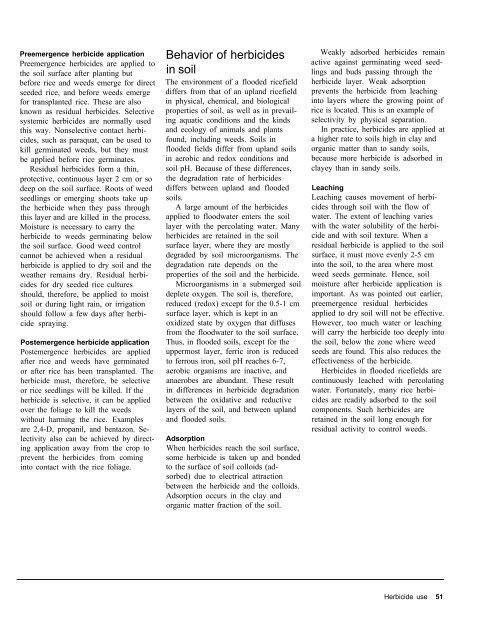A handbbok on Weed Control in Rice.pdf
A handbbok on Weed Control in Rice.pdf
A handbbok on Weed Control in Rice.pdf
You also want an ePaper? Increase the reach of your titles
YUMPU automatically turns print PDFs into web optimized ePapers that Google loves.
Preemergence herbicide applicati<strong>on</strong><br />
Preemergence herbicides are applied to<br />
the soil surface after plant<strong>in</strong>g but<br />
before rice and weeds emerge for direct<br />
seeded rice, and before weeds emerge<br />
for transplanted rice. These are also<br />
known as residual herbicides. Selective<br />
systemic herbicides are normally used<br />
this way. N<strong>on</strong>selective c<strong>on</strong>tact herbi-<br />
cides, such as paraquat, can be used to<br />
kill germ<strong>in</strong>ated weeds, but they must<br />
be applied before rice germ<strong>in</strong>ates.<br />
Residual herbicides form a th<strong>in</strong>,<br />
protective, c<strong>on</strong>t<strong>in</strong>uous layer 2 cm or so<br />
deep <strong>on</strong> the soil surface. Roots of weed<br />
seedl<strong>in</strong>gs or emerg<strong>in</strong>g shoots take up<br />
the herbicide when they pass through<br />
this layer and are killed <strong>in</strong> the process.<br />
Moisture is necessary to carry the<br />
herbicide to weeds germ<strong>in</strong>at<strong>in</strong>g below<br />
the soil surface. Good weed c<strong>on</strong>trol<br />
cannot be achieved when a residual<br />
herbicide is applied to dry soil and the<br />
weather rema<strong>in</strong>s dry. Residual herbi-<br />
cides for dry seeded rice cultures<br />
should, therefore, be applied to moist<br />
soil or dur<strong>in</strong>g light ra<strong>in</strong>, or irrigati<strong>on</strong><br />
should follow a few days after herbi-<br />
cide spray<strong>in</strong>g.<br />
Postemergence herbicide applicati<strong>on</strong><br />
Postemergence herbicides are applied<br />
after rice and weeds have germ<strong>in</strong>ated<br />
or after rice has been transplanted. The<br />
herbicide must, therefore, be selective<br />
or rice seedl<strong>in</strong>gs will be killed. If the<br />
herbicide is selective, it can be applied<br />
over the foliage to kill the weeds<br />
without harm<strong>in</strong>g the rice. Examples<br />
are 2,4-D, propanil, and bentaz<strong>on</strong>. Se-<br />
lectivity also can be achieved by direct-<br />
<strong>in</strong>g applicati<strong>on</strong> away from the crop to<br />
prevent the herbicides from com<strong>in</strong>g<br />
<strong>in</strong>to c<strong>on</strong>tact with the rice foliage.<br />
Behavior of herbicides<br />
<strong>in</strong> soil<br />
The envir<strong>on</strong>ment of a flooded ricefield<br />
differs from that of an upland ricefield<br />
<strong>in</strong> physical, chemical, and biological<br />
properties of soil, as well as <strong>in</strong> prevail-<br />
<strong>in</strong>g aquatic c<strong>on</strong>diti<strong>on</strong>s and the k<strong>in</strong>ds<br />
and ecology of animals and plants<br />
found, <strong>in</strong>clud<strong>in</strong>g weeds. Soils <strong>in</strong><br />
flooded fields differ from upland soils<br />
<strong>in</strong> aerobic and redox c<strong>on</strong>diti<strong>on</strong>s and<br />
soil pH. Because of these differences,<br />
the degradati<strong>on</strong> rate of herbicides<br />
differs between upland and flooded<br />
soils.<br />
A large amount of the herbicides<br />
applied to floodwater enters the soil<br />
layer with the percolat<strong>in</strong>g water. Many<br />
herbicides are reta<strong>in</strong>ed <strong>in</strong> the soil<br />
surface layer, where they are mostly<br />
degraded by soil microorganisms. The<br />
degradati<strong>on</strong> rate depends <strong>on</strong> the<br />
properties of the soil and the herbicide.<br />
Microorganisms <strong>in</strong> a submerged soil<br />
deplete oxygen. The soil is, therefore,<br />
reduced (redox) except for the 0.5-1 cm<br />
surface layer, which is kept <strong>in</strong> an<br />
oxidized state by oxygen that diffuses<br />
from the floodwater to the soil surface.<br />
Thus, <strong>in</strong> flooded soils, except for the<br />
uppermost layer, ferric ir<strong>on</strong> is reduced<br />
to ferrous ir<strong>on</strong>, soil pH reaches 6-7,<br />
aerobic organisms are <strong>in</strong>active, and<br />
anaerobes are abundant. These result<br />
<strong>in</strong> differences <strong>in</strong> herbicide degradati<strong>on</strong><br />
between the oxidative and reductive<br />
layers of the soil, and between upland<br />
and flooded soils.<br />
Adsorpti<strong>on</strong><br />
When herbicides reach the soil surface,<br />
some herbicide is taken up and b<strong>on</strong>ded<br />
to the surface of soil colloids (ad-<br />
sorbed) due to electrical attracti<strong>on</strong><br />
between the herbicide and the colloids.<br />
Adsorpti<strong>on</strong> occurs <strong>in</strong> the clay and<br />
organic matter fracti<strong>on</strong> of the soil.<br />
Weakly adsorbed herbicides rema<strong>in</strong><br />
active aga<strong>in</strong>st germ<strong>in</strong>at<strong>in</strong>g weed seedl<strong>in</strong>gs<br />
and buds pass<strong>in</strong>g through the<br />
herbicide layer. Weak adsorpti<strong>on</strong><br />
prevents the herbicide from leach<strong>in</strong>g<br />
<strong>in</strong>to layers where the grow<strong>in</strong>g po<strong>in</strong>t of<br />
rice is located. This is an example of<br />
selectivity by physical separati<strong>on</strong>.<br />
In practice, herbicides are applied at<br />
a higher rate to soils high <strong>in</strong> clay and<br />
organic matter than to sandy soils,<br />
because more herbicide is adsorbed <strong>in</strong><br />
clayey than <strong>in</strong> sandy soils.<br />
Leach<strong>in</strong>g<br />
Leach<strong>in</strong>g causes movement of herbi-<br />
cides through soil with the flow of<br />
water. The extent of leach<strong>in</strong>g varies<br />
with the water solubility of the herbi-<br />
cide and with soil texture. When a<br />
residual herbicide is applied to the soil<br />
surface, it must move evenly 2-5 cm<br />
<strong>in</strong>to the soil, to the area where most<br />
weed seeds germ<strong>in</strong>ate. Hence, soil<br />
moisture after herbicide applicati<strong>on</strong> is<br />
important. As was po<strong>in</strong>ted out earlier,<br />
preemergence residual herbicides<br />
applied to dry soil will not be effective.<br />
However, too much water or leach<strong>in</strong>g<br />
will carry the herbicide too deeply <strong>in</strong>to<br />
the soil, below the z<strong>on</strong>e where weed<br />
seeds are found. This also reduces the<br />
effectiveness of the herbicide.<br />
Herbicides <strong>in</strong> flooded ricefields are<br />
c<strong>on</strong>t<strong>in</strong>uously leached with percolat<strong>in</strong>g<br />
water. Fortunately, many rice herbi-<br />
cides are readily adsorbed to the soil<br />
comp<strong>on</strong>ents. Such herbicides are<br />
reta<strong>in</strong>ed <strong>in</strong> the soil l<strong>on</strong>g enough for<br />
residual activity to c<strong>on</strong>trol weeds.<br />
Herbicide use 51











